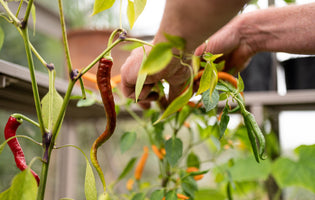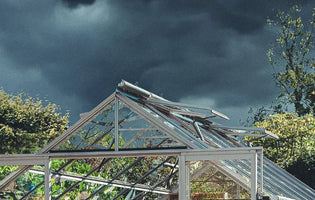With the coming of fall, there’s no reason why you should stop growing a wide variety of plants. Indeed, this colorful season is an ideal opportunity for gardeners to cultivate a diverse range of crops, many of which will thrive in cooler temperatures and more moisture.

Whether this fall will be your first gardening journey, or you are a seasoned gardener looking for ideas, our fall growing guide will give you valuable insights into the best plants you can grow in the fall.
Cool season vegetables
As we’re starting to near the end of the summer, gardeners are turning their thoughts to fall, and this season is the perfect time to grow vegetables that are happy with cooler temperatures and less sunshine.
Leafy greens are particularly popular with seasoned vegetable growers during this season, like spinach (the more you cut leaves off, the more it grows), kale and lettuce. Kale is easy to grow and is hardy but start them off in a polytunnel, under a cloche or a fleece. Always remove the flowers from leafy plants so they don’t go to seed unless you want to collect seeds for next year’s planting. Make sure you choose a hardy variety of lettuce, and they are best when grown undercover or in a greenhouse. Rocket is a great compliment to lettuce, just a little spicier than the milder tasting lettuce, and mustard leaf has a lovely peppery flavor.
It’s also worth considering cruciferous vegetables, such as cauliflower, broccoli and even Brussels sprouts! These, and many other vegetable crops, are fairly hardy and are capable of withstanding a light frost or two, making them the perfect choice for fall planting. Broad beans are the most hardy of the bean family and thrive in fallal conditions, but you must harvest them before the harsh winter months of January and February. Get winter cabbage and leeks in the ground now for fall and winter harvesting and protect them from caterpillars.
Root vegetables
As well as the leafy and cruciferous veg, plenty of root vegetables will grow well in the cooler fall climate. In fact, many of them are more flavorsome when grown at this time of year.
Root vegetables that grow well in fall include carrots, beetroots, and radishes – the Asian, Mooli, Watermelon, or Spanish Black varieties are good options – parsnips and the less popular, but equally delicious, turnip. Although their growth may be slower and steadier than in spring, they will provide you with a good supply of vegetables over the fall and winter months. Just harvest them as you need them when they have reached a good size.
Herbs
Herbs are always a popular addition to any garden of any size, and many different types of herbs grow very well during fall. The leafier the herb, the better the results, so consider herbs like parsley, cilantro, thyme, bay leaves, rosemary, sage, oregano, coriander and chives.
Being able to pop outside or to the greenhouse and cut fresh herbs, as and when you need them, to add flavor to any fall or winter dish is immensely satisfying. Herbs are also great for making pesto, sauces, and vinaigrettes and are delicious added to warming soups.
Herbs like rosemary and lavender will grow well outside and are perennial but ensure they are in well-drained soil. Not all varieties of mint grow well in fall, so pick the type of mint that is suited to this season. Others will thrive better in a greenhouse, under cloches or a tunnel, or on a windowsill where they have protection from the elements, particularly the rain and dampness.
Flowers
Of course, fall isn’t just about growing vegetables and herbs. There’s no better way to brighten up a fall garden, greenhouse or indoors than with color. There are plenty of beautiful fall flowering plants that will do just that.
Traditional flowers that bloom in fall include chrysanthemums, asters and pansies. But you may also want to think about rudbeckias which come in wonderful shades of orange, red, yellow and bronze. They have a long period of flowers and are great as cut flowers, too. Crocosmias have bold, bright colors and look similar to orchids, adding plenty of variety to your garden, and amarines are similar but with more pastel colors. Penstemons are also popular, especially as they are easy to grow and pest resistant. Kniphofias will add height with flowers on spikes, while colchicums are ideal for the front of flower beds due to their small stature. But they make up for the lack of height by being hardy, durable and easy to grow.
Garlic
Planting garlic in the fall is all about establishing its roots before winter sets in, which will lead to larger, more robust and flavorsome bulbs the following year. You may want to start the cloves off in pots in a greenhouse or under cover to protect them from a harsh winter, then sow out in the spring in well-prepared, free-draining soil.
Cover crops
If you’ve got not-so-perfect soil, like clay, or it isn’t very fertile, consider growing cover crops over the fall and winter. They are a great way to improve soil structure and provide plenty of good nutrients. They also help to prevent erosion and can suppress weed growth during this time of year.
Good cover crops include different types of brassicas, like turnips, radishes and mustards, grasses and cereals – corn, rye and soybeans – and legumes, such as clovers, lucerne and common or hairy vetch.
Clovers are particularly popular and come in many varieties, like red, white alsike, crimson and sweet clovers. You could also consider alfalfa and canola, also known as rapeseed and easily recognized by their bright yellow flowers. The best time to plant cover crops is mid to late September, although with legumes this may vary.
Perennial planting
Fall is the season associated with planting bulbs and perennial plants, like berry bushes, fruit trees and even asparagus crowns. At this time of the year, it is cooler, and more rain is likely, giving the plants ample opportunity to establish good, strong roots and embed themselves before they hit winter dormancy.
Blackberries possibly have the longest growing season into fall, producing juicy berries right into mid-October, and they are great for making jellies and jams and adding to puddings. The elderberry bush is often known more for its flowers, but in fall its berries hang in clusters and make great cordials, syrups and wine, as do rosehip berries which are packed with vitamin C. Sloe berries are particularly popular for making sloe gin or wine but can also be used to make sauces and jellies, although they need sugar to reduce their bitterness if eaten raw.
Rowanberries, plums and damsons, a wild type of plum, are great fruit trees for fall harvests, while raspberry canes also stand tall at this time of the year, but you’ll need to have these covered to protect them from birds. Gooseberry trees produce plenty of fruit in the fall and are delicious in pies, puddings and as a gooseberry fool.
Contrary to popular belief, you can plant bare-rooted asparagus crowns in early fall, into soil that is still relatively warm. This allows them to set down their roots before the winter months, but they will need a permanent home in your garden. Make sure it’s a sunny but sheltered position and in well-drained, fertile soil. But remember, your first crop won’t be ready for harvesting for a couple of years as they need to fully establish themselves. After that, each asparagus crown can grow as many as 25 spears a year and will continue to do so for years to come. So, if you’ve not grown them before and have a patch in your garden that you’re happy to turn over to asparagus long-term, it’s worth giving them a go this fall.
One thing that is sure for gardeners is that growing vegetables, flowers, fruit and many other plants doesn’t have to stop just because fall has arrived. However, you may find it easier to make the most of this growing season by investing in a greenhouse. Alternatively, consider glass cloches or polytunnels to help your plants thrive.
If you want to find out more about year-round growing, be sure to check out our in-depth monthly seed sowing guide. The guide takes you through each month of the year and gives you the perfect time to begin sowing seeds to optimize your gardening schedule.







